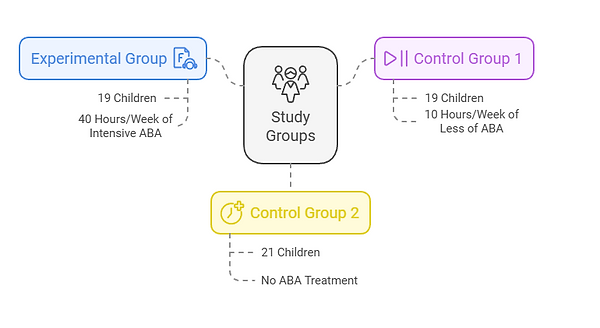
Why Early Intervention Matters!
Early intervention is crucial for children with developmental delays or disabilities, as it can significantly enhance their development and improve long-term outcomes. Research published in the Journal of Applied Behavior Analysis (JABA) provides empirical support for the effectiveness of early intervention strategies.
.png)
Dr. O. Ivar Lovaas (UCLA study)
The 1987 UCLA study by Dr. O. Ivar Lovaas is one of the most cited and influential studies in the field of Applied Behavior Analysis (ABA) and autism intervention
Participants and Methods

Pre- and post-intervention assessments were conducted to measure intellectual functioning, adaptive behavior, and academic performance. Tools included standardized IQ tests and measures of educational achievement.
Outcomes
.png)
47% pass through first grade in public schools
40% passed first grade in a special needs school
2% pass through first grade in public schools
No significant improvement seen
Discussions
While the 1987 Lovaas study was groundbreaking in demonstrating the potential of intensive Applied Behavior Analysis (ABA) for children with autism, subsequent research has expanded our understanding of effective intervention strategies. Notably, studies have highlighted the benefits of integrating family involvement and suggest that less intensive, yet still individualized, ABA interventions can be effective.
Family Collaboration in ABA Interventions
Involving families in the therapeutic process has been shown to enhance treatment outcomes. A study published in JMIR Pediatrics and Parenting examined the impact of parent-led ABA treatment and found that such involvement can lead to significant progress in skill acquisition across multiple domains for children with autism. This underscores the importance of family participation in the intervention process.
Effectiveness of Less Intensive ABA Interventions
Recent research challenges the notion that higher intensity always correlates with better outcomes. A 2024 study from the University of North Carolina School of Medicine analyzed data from 144 early childhood intervention studies involving over 9,000 children. The findings indicated no significant evidence that higher intensity interventions provided increased benefits for young autistic children, suggesting that less intensive interventions can be equally effective when appropriately tailored.
Individualization of ABA Treatment
The principle of individualization is central to ABA, emphasizing that interventions should be tailored to each person's unique needs. A study in BMC Psychiatry highlighted the effectiveness of comprehensive ABA-based interventions in treating autism, noting that individualized approaches are crucial for addressing the diverse needs of individuals with autism.
Conclusion
Early intervention is critical for maximizing the developmental potential of children with autism or developmental delays. When parents sense that something may not be quite right, it is essential to trust their instincts and seek professional guidance without delay. Timely intervention can significantly improve outcomes, helping children reach their fullest potential.
Applied Behavior Analysis (ABA) remains a cornerstone of effective intervention, as it provides a scientific framework for teaching new skills. The principles of ABA offer proven methodologies for fostering meaningful and lasting behavioral change. However, as research evolves, it has become clear that the intensity of ABA interventions is not as crucial as once thought. Instead, the focus should shift to tailoring treatments to meet the unique needs of each individual.
Individualized intervention plans, designed with the individual's strengths and challenges in mind, ensure that therapy is not just effective but also meaningful. By targeting the specific needs of each person, we can empower them to lead enriched and fulfilling lives. Early action combined with a personalized approach lays the foundation for success.
References
-
Lovaas, O. I. (1987). Behavioral treatment and normal educational and intellectual functioning in young autistic children. Journal of Consulting and Clinical Psychology, 55(1), 3–9.
-
Smith, T., Groen, A. D., & Wynn, J. W. (2000). Randomized trial of intensive early intervention for children with pervasive developmental disorder. American Journal on Mental Retardation, 105(4), 269–285.
-
Reichow, B., & Wolery, M. (2009). Comprehensive synthesis of early intensive behavioral interventions for young children with autism. Journal of Autism and Developmental Disorders, 39(1), 23–41.
-
"Parent-led ABA treatment: Enhancing outcomes through family collaboration." JMIR Pediatrics and Parenting. Available at: https://pediatrics.jmir.org/2024/1/e62878
-
"New study suggests higher amounts of intervention may not be more helpful for children on the autism spectrum." UNC Healthcare News. Published June 2024. Available at: https://news.unchealthcare.org/2024/06/new-study-suggests-higher-amounts-of-intervention-may-not-be-more-helpful-for-children-on-the-autism-spectrum/
-
Shaping, A., et al. (2022). "The role of comprehensive ABA-based interventions for autism: Individualized approaches for better outcomes." BMC Psychiatry. Available at: https://bmcpsychiatry.biomedcentral.com/articles/10.1186/s12888-022-04412-1




